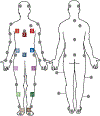Center of Mass Estimation for Impaired Gait Assessment Using Inertial Measurement Units
- PMID: 38090847
- PMCID: PMC10849874
- DOI: 10.1109/TNSRE.2023.3341436
Center of Mass Estimation for Impaired Gait Assessment Using Inertial Measurement Units
Abstract
Injury or disease often compromise walking dynamics and negatively impact quality of life and independence. Assessing methods to restore or improve pathological gait can be expedited by examining a global parameter that reflects overall musculoskeletal control. Center of mass (CoM) kinematics follow well-defined trajectories during unimpaired gait, and change predictably with various gait pathologies. We propose a method to estimate CoM trajectories from inertial measurement units (IMUs) using a bidirectional Long Short-Term Memory neural network to evaluate rehabilitation interventions and outcomes. Five non-disabled volunteers participated in a single session of various dynamic walking trials with IMUs mounted on various body segments. A neural network trained with data from four of the five volunteers through a leave-one-subject out cross validation estimated the CoM with average root mean square errors (RMSEs) of 1.44cm, 1.15cm, and 0.40cm in the mediolateral (ML), anteroposterior (AP), and inferior/superior (IS) directions respectively. The impact of number and location of IMUs on network prediction accuracy was determined via principal component analysis. Comparing across all configurations, three to five IMUs located on the legs and medial trunk were the most promising reduced sensor sets for achieving CoM estimates suitable for outcome assessment. Lastly, the networks were tested on data from an individual with hemiparesis with the greatest error increase in the ML direction, which could stem from asymmetric gait. These results provide a framework for assessing gait deviations after disease or injury and evaluating rehabilitation interventions intended to normalize gait pathologies.
Figures





References
-
- Perry J, Gait Analysis: Normal and Pathological Function, 2nd ed. Thorofare, NJ, USA: Slack, 2010.

